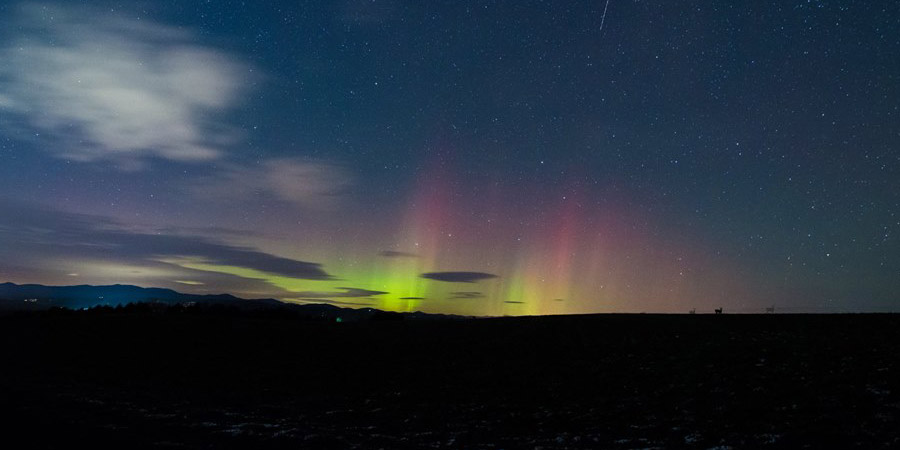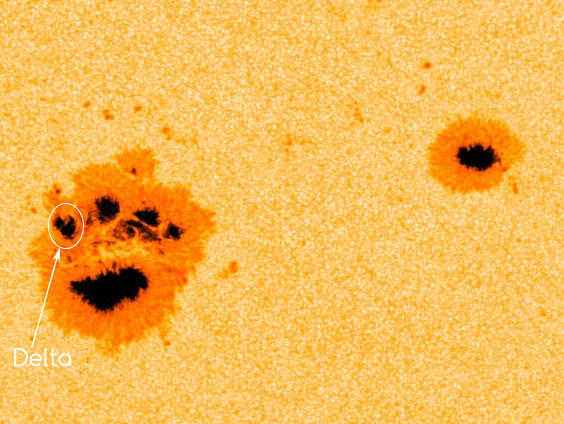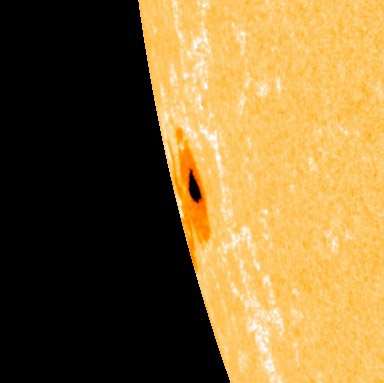Low solar activity, 2197 returns, coronal hole effects
Wednesday, 19 November 2014 21:39 UTC

Solar activity is at low levels (C-class solar flares only) despite the presence of sunspot region 2209 which still has a Beta-Gamma-Delta magnetic layout. Why is it so quiet and can we still expect strong solar flares from this sunspot region? We are also seeing the appearance of a new sunspot region near the east limb which is likely the return of sunspot region 2197. Back here on Earth we see continuing but waning coronal hole high speed stream effects. High latitude locations have been experiencing fantastic auroral displays for several days now. Our header image was taken just a few days ago by Durwood Mark Collier from Vermont, USA. Stunning!
Sunspot region 2209
Solar activity is at low levels (C-class solar flares only) despite the presence of sunspot region 2209 which still has a Beta-Gamma-Delta magnetic layout. It keeps one solid and compact delta sunspot among the trailing sunspots. Sunspot region 2209 is however rather static and doesn't change a whole lot which might explain the lack of flaring. We nonetheless can not exclude an M-class event from this sunspot region as it's compact delta structure does have the potential to produce a moderately strong solar event.

M-class flare probability for the coming 24 hours: 25% chance
X-class flare probability for the coming 24 hours: 5% chance
All the other sunspot regions on the disk are unremarkable and unlikely to produce strong solar flares. Any future solar flares will very likely be centered around sunspot region 2209. Sunspot region 2209 is now directly facing Earth and any eruptions from sunspot region 2209 will likely be earth-directed in the days ahead.
Sunspot region 2197 returns
Another sunspot region that we should note is now coming around the east limb. This is likely the return of sunspot region 2197 and it seemes that is has grown on the farside of the Sun. It might actually have been larger than it currently is as we see substantial amounts of faculae around this sunspot region. We will nonetheless monitor this sunspot region in the days ahead to see if it has the potential to produce a strong solar flare.

Coronal hole effects
Earth is currently under the influence of waning coronal hole high speed stream effects. The past week or so we have been seeing enhanced solar wind conditions as multiple coronal hole high speed streams affected Earth. The Kp-index reached 4 (active geomagnetic conditions) on several occasions which gave us amazing auroral displays at many high latitude locations like Norway where this stunning image was captured by Tor-Ivar Næss.

Solar wind conditions will likely slowly drop down to background levels as the coronal hole high speed stream effects continue to wane. No coronal mass ejections or coronal hole high speed streams are expected to reach Earth in the coming days.
Images: NASA SDO, Durwood Mark Collier, Tor-Ivar Næss.
Thank you for reading this article! Did you have any trouble with the technical terms used in this article? Our help section is the place to be where you can find in-depth articles, a FAQ and a list with common abbreviations. Still puzzled? Just post on our forum where we will help you the best we can!
Latest news
Latest forum messages
Support SpaceWeatherLive.com!
A lot of people come to SpaceWeatherLive to follow the Sun's activity or if there is aurora to be seen, but with more traffic comes higher server costs. Consider a donation if you enjoy SpaceWeatherLive so we can keep the website online!

Space weather facts
| Last X-flare | 2025/01/04 | X1.85 |
| Last M-flare | 2025/01/22 | M1.3 |
| Last geomagnetic storm | 2025/01/04 | Kp5 (G1) |
| Spotless days | |
|---|---|
| Last spotless day | 2022/06/08 |
| Monthly mean Sunspot Number | |
|---|---|
| December 2024 | 154.5 +2 |
| January 2025 | 145.8 -8.7 |
| Last 30 days | 161.9 +43 |


